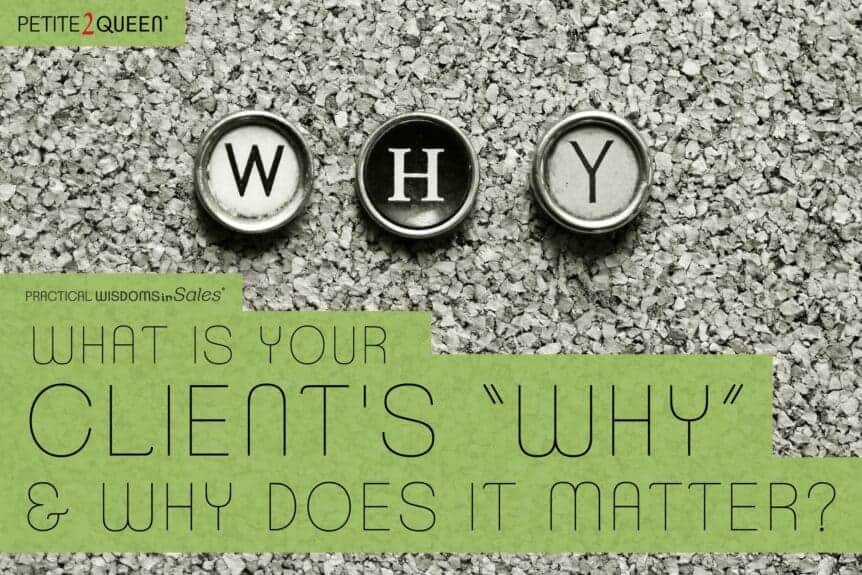Despite our best intentions, it can be difficult to connect with clients well enough to discover steadfast solutions for their particular needs. Thinking like your client gives you a major competitive edge in sales, and applying this mindset will help you reach your client’s ideal solution.
However, a key aspect of thinking like your client is that you need to identify their “why” and how to incorporate their perspective into your sales strategy. You have to focus on what your client wants, needs, and lacks. You have to find their pain points.
Using these pain points to reverse engineer your product or service to fit those needs is what will help you crack the code on how you can best attract and connect with clients.
Ask These Questions
To create your sales strategy, you need to answer:
- Who is your client? Niche down to a specific target audience, even if you think your product or service could potentially serve everyone. Remember: If you try selling to everyone, you will be selling to no one.
- What is your client’s problem? What do they want, need, or lack? What are they trying to solve, address, or overcome?
- What are they looking for? What solution do they want? What does it look like? How will it be delivered? How long will it take? What would make it simple and easy for them to implement?
- How will this solution help them? Your product or service should benefit them by creating a positive impact on your client personally or professionally, in their business, family, and community. Why does your solution matter?
- What will the solution allow them to do? This is the most important question. “I want this solution so I can…” what? What is the dream outcome, goal, and desire?
Your answer to question one, who is the client, should guide you through questions two through five. Keep your specific audience in mind when asking these crucial questions!
Once you have your answers, you can reverse engineer how your product or service serves your clients. This is what will quickly attract and connect with your ideal clients.
Conduct Interviews
While it’s important for you to answer the five questions on your own to focus your mind and efforts, you should also get feedback from outside parties. Ideally, you should interview at least seven people: current clients, past clients, near misses, and ideal clients. They can’t all be current clients because you are trying to find the gaps in your client’s thinking (and yes, there are always gaps!).
Ask your interviewees open-ended questions about the wants, needs, pain points, and areas of concern that you have identified. Cover the who, what, where, when, why, and how. Ask about the value they place on a product or service, how they use it, and how it could be different or better. What benefits have they received, and which ones matter most? What does the solution allow them to do?
During these interviews, try to keep your questions and tone neutral – you don’t want to influence the answers! These interviews shouldn’t take longer than 30 minutes, and the information you gain will be invaluable.
The Client’s Why
After you’ve completed the interviews, compare their answers to the client thinking exercise we discussed in our previous article. You might need to go back through the exercise again with this new information, and that’s okay! It will help you precisely navigate your way to the client’s “why” and how your solution will help them.
After doing this work, you can approach a potential client and frame your product or service in a way that demonstrates how it can help them. Your solution will fulfill what the client needs, provide real benefits to them, and allow them to achieve their goals. Tell them how your product or service will be delivered, what it looks like, how long it will take, and how you will make it simple and easy for them.
IMPORTANT: You are not trying to trick your client into thinking they need your solution! Do not frame your product or service as being useful to them if it just isn’t a good fit.
The more you know about your clients, the easier you’ll understand them and be able to connect with them. Being able to identify your ideal customer and tailoring your offer and messaging will only benefit you in the long run.
Not sure where to start when it comes to understanding your clients and creating a valuable sales offer? Contact our team and let us support you on your way to success.

Lynn Whitbeck is the co-founder and President of Petite2Queen. She is focused on identifying and evaluating opportunities for women at work, helping them define their personal roadmap. She dedicates herself to delivering tools and insights, embracing visualization of the big picture, and identifying and implementing the minutiae of detail. Lynn aims to share lessons learned along her journey and enable positive uplift for women.

